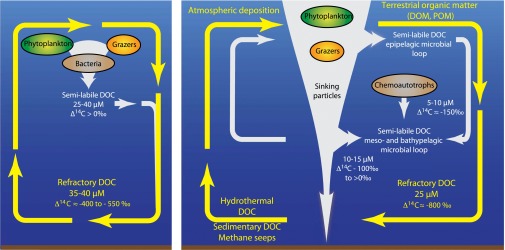Fig. 3.

Physical interpretation. Schematic contrasting DOC cycling in the two-component model (Left) and the multicomponent model proposed here (Right). In the two-component model, DOC with a modern radiocarbon value is added to surface seawater as a byproduct of microbial carbon production and cycling, such that surface DOC concentrations are relatively high (typically 60–80 μM) and enriched in radiocarbon ( to ). The semilabile component of DOC (25–40 μM; ) is removed in the mesopelagic ocean, leaving a background fraction of refractory DOC (35–40 μM; to ) that cycles through the ocean over several millennia. Our results (Right) show that a large fraction of the sinking particle flux through 500 m, with a modern radiocarbon value from to , accumulates in the deep ocean where it cycles over decadal timescales through the meso- and bathypelagic microbial loops. Chemo- and lithoautotrophy, as well as advection, also contribute to deep semilabile DOC. The refractory fraction of DOC (yellow arrow) has a lower concentration and older mean radiocarbon age than predicted by the TCM. The direct input of refractory carbon, or microbial cycling of semilabile carbon from terrestrial organic matter (atmospheric deposition, rivers, groundwater, desorption from particulate POC), hydrothermal vents, methane, and fossil carbon from seeps, sediments, and the atmosphere is consistent with stable carbon isotopic distributions.
